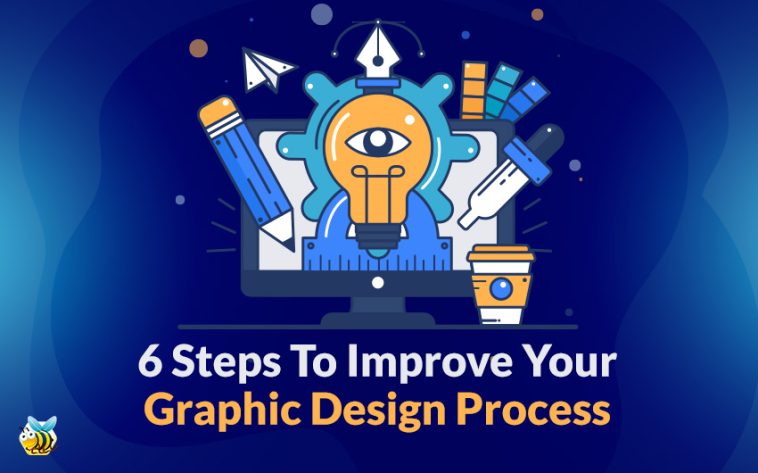By sheer coincidence, you find yourself struggling to meet the demands of your graphic design projects. Whether it’s a lack of efficiency, creativity, or client satisfaction, there’s room for improvement in your design process.
But fear not, for there are six simple steps that can help you overcome these challenges and elevate your graphic design game. These steps will not only enhance your workflow but also enable you to deliver impactful designs that resonate with your audience.
So, buckle up and get ready to transform your design process into a well-oiled machine that yields impressive results.
Key Takeaways
- Clearly define design objectives and set SMART goals to guide your work.
- Conduct thorough research and gather inspiration from various sources to inform your design decisions.
- Use effective brainstorming and sketching techniques to generate and refine ideas.
- Streamline the feedback and revision process by establishing clear communication and utilizing visual collaboration tools.
Setting Clear Design Objectives
To improve your graphic design process, start by setting clear design objectives. Clarifying objectives is essential because it provides a roadmap for your work. When you have a clear understanding of what you want to achieve, you can focus your efforts and make informed decisions throughout the design process.
Goal setting is a crucial step in clarifying objectives. It allows you to identify what you want to accomplish with your design and helps you stay on track. By setting specific, measurable, achievable, relevant, and time-bound (SMART) goals, you can create a clear path to success.
When setting design objectives, consider your target audience and the purpose of your design. Ask yourself questions like: Who’s the design for? What message do I want to convey? What action do I want the audience to take? By answering these questions, you can align your objectives with the needs and expectations of your audience.
Conducting Thorough Research and Gathering Inspiration
Once you have set clear design objectives, the next step in improving your graphic design process is to thoroughly research and gather inspiration. Research techniques are essential in helping you understand the target audience, industry trends, and competitors.
Start by conducting a thorough analysis of the client’s requirements and expectations. Dive deep into the subject matter, whether it’s a product, service, or event, to gain a comprehensive understanding. Explore various resources such as books, articles, and online platforms to gather relevant information.
To gather creative inspiration, explore different design styles, color palettes, and typography trends. Look for inspiration in various industries, not just graphic design. Expose yourself to art, fashion, architecture, and nature to broaden your creative horizons. Visit museums, attend exhibitions, and explore online galleries to discover fresh ideas. Create mood boards or digital scrapbooks to collect visuals that resonate with your design objectives.
Additionally, engage with other designers and professionals in the field. Attend design conferences, join online communities, and participate in workshops to exchange ideas and learn from others. Be open to feedback and critique to refine your design process.
Effective Brainstorming and Sketching Techniques
Now let’s talk about effective brainstorming and sketching techniques to enhance your graphic design process.
When it comes to brainstorming, try techniques like mind mapping or free association to generate ideas.
When it’s time to sketch, remember to start with rough sketches to explore different concepts before refining your designs.
These techniques will help you generate creative ideas and bring them to life through sketches.
Brainstorming Techniques
Enhance your graphic design process by employing effective brainstorming and sketching techniques.
Creative thinking is essential for generating new ideas in graphic design. When brainstorming, it’s important to create an open and non-judgmental environment where all ideas are welcome. Encourage team members to think outside the box and explore different perspectives.
To facilitate idea generation, try using techniques like mind mapping, where ideas are visually represented and connected to each other. Another effective method is the ‘six thinking hats’ technique, which encourages different modes of thinking, such as critical thinking, creative thinking, and optimistic thinking.
Sketching is also a valuable tool for brainstorming. By quickly sketching out your ideas, you can visualize them and refine them further. Remember, the goal of brainstorming is to generate a wide range of ideas, so don’t be afraid to think big and let your creativity flow.
Sketching Tips
To improve your graphic design process, incorporate these sketching tips for effective brainstorming and sketching techniques.
Quick sketching is a valuable tool in the initial stages of graphic design. It allows you to quickly explore ideas and concepts without getting caught up in details. Use loose, quick strokes to capture the essence of your ideas and iterate on them.
Digital tools can enhance your sketching process by providing flexibility and convenience. Use a tablet or a digital sketching app to create digital sketches that can be easily edited and shared. Experiment with different brushes and colors to bring your ideas to life.
Streamlining the Feedback and Revision Process
Make the feedback and revision process more efficient by implementing streamlined strategies.
Improving communication and managing client expectations are crucial aspects of this process. To begin, establish clear lines of communication with your clients from the start. This can be done by using project management tools or setting up regular check-in meetings. By keeping the lines of communication open, you can address any concerns or questions the client may have, ensuring that their expectations are met.
Additionally, providing clients with a clear timeline for revisions can help manage their expectations. Specify the number of revisions included in the project and set realistic deadlines for each round of feedback. This will prevent any misunderstandings and keep the project moving forward smoothly.
Another strategy is to consolidate feedback from multiple stakeholders. Instead of receiving feedback from each individual separately, encourage clients to gather their thoughts and provide comprehensive feedback all at once. This will save time and prevent confusion caused by conflicting feedback.
Lastly, consider using visual collaboration tools that allow clients to annotate and provide feedback directly on the designs. This eliminates the need for lengthy email chains and increases efficiency.
Utilizing Design Tools and Software for Efficiency
To improve your graphic design process, it’s essential to utilize efficient design software and streamline your design tools.
By using software specifically designed for graphic design, you can increase productivity and efficiency in your workflow.
Additionally, finding ways to streamline your design tools, such as organizing and categorizing them effectively, can help you save time and work more efficiently.
Efficient Design Software
Maximize your workflow efficiency with the right design software and tools.
When it comes to graphic design, having efficient design software is crucial. Design software tools can greatly enhance your productivity and streamline your design process.
With the right software, you can easily create, edit, and manipulate your designs, saving you time and effort. Look for design software that offers a wide range of features and capabilities, such as advanced editing tools, vector graphics support, and easy integration with other design applications.
Additionally, consider software that allows for collaboration and sharing, enabling you to work seamlessly with other team members or clients.
Streamlining Design Tools
Optimize your design process by leveraging efficient design tools and software.
Streamlining your design tools is essential for improving efficiency and optimizing workflow. One way to do this is by using design software that offers a wide range of features and capabilities. Look for software that allows you to easily create and modify designs, offers a smooth interface, and provides quick access to commonly used tools.
Additionally, consider using plugins and extensions that can enhance your design process by providing additional functionality and streamlining repetitive tasks.
Delivering the Final Product With Impact
Ensure that your final graphic design product leaves a lasting impression. To achieve this, focus on delivering impactful designs and implementing effective communication strategies.
When it comes to delivering impactful designs, consider the overall visual appeal, composition, and use of colors, typography, and images. Aim to create designs that not only catch the viewer’s attention but also effectively convey the intended message.
Effective communication strategies are crucial in delivering a final product with impact. Start by understanding the client’s needs and objectives. This will help you tailor your design to meet their expectations. Regular communication with the client throughout the design process is essential to ensure that you’re on the right track and can make any necessary adjustments.
Additionally, consider the target audience when delivering the final product. Analyze their preferences, demographics, and behavior to create designs that resonate with them. Use persuasive elements such as strong visual hierarchy, clear call-to-actions, and compelling visuals to engage the audience and leave a lasting impact.
Frequently Asked Questions
What Are Some Common Challenges Designers Face When Setting Clear Design Objectives?
When setting clear design objectives, designers often face common challenges. Conducting effective research is crucial to overcome these obstacles.
By not clearly defining design objectives, designers may struggle to meet client expectations and deliver successful designs. Without proper research, designers may lack a deep understanding of the target audience, resulting in ineffective designs.
It’s important for designers to prioritize setting clear objectives and conducting thorough research to ensure successful graphic design projects.
How Can Designers Ensure That They Conduct Thorough Research and Gather Inspiration Effectively?
To ensure you conduct thorough research and gather inspiration effectively, start by defining your project’s goals and target audience.
Next, focus on conducting research by exploring relevant industry trends, competitors, and target audience preferences. Use online resources, such as design blogs, social media, and portfolio websites, to gather inspiration.
Additionally, attend design conferences and workshops to stay updated with the latest design trends and techniques.
Are There Any Specific Brainstorming and Sketching Techniques That Can Help Designers Come Up With Innovative Ideas?
To come up with innovative ideas, try using brainstorming techniques and sketching methods.
Brainstorming allows you to generate a wide range of ideas by encouraging free thinking and collaboration. You can try techniques like mind mapping or word association to spark creativity.
Sketching helps you visually explore and refine your ideas. Use quick sketches or thumbnail sketches to quickly capture and iterate on different concepts.
These techniques can help you think outside the box and come up with fresh, innovative designs.
What Are Some Strategies for Streamlining the Feedback and Revision Process to Ensure Efficient Collaboration Between Designers and Clients?
To ensure efficient collaboration between you and your clients, it’s important to streamline the feedback and revision process. One strategy is to establish clear communication channels, such as using a project management tool or scheduling regular check-ins.
Encourage clients to provide specific and actionable feedback to avoid unnecessary back-and-forth. Additionally, set realistic timelines and expectations for revisions to keep the process moving smoothly.
Regularly update clients on the progress and involve them in the decision-making process to ensure their satisfaction.
Can You Recommend Any Design Tools or Software That Can Improve Efficiency in the Graphic Design Process?
Design collaboration tools and design project management software can greatly improve efficiency in your graphic design process. These tools allow you to streamline communication and collaboration between designers and clients, making it easier to share files, gather feedback, and track revisions.






One Ping
Pingback:6 Steps To Improve Your Graphic Design Process – PNG Downloads